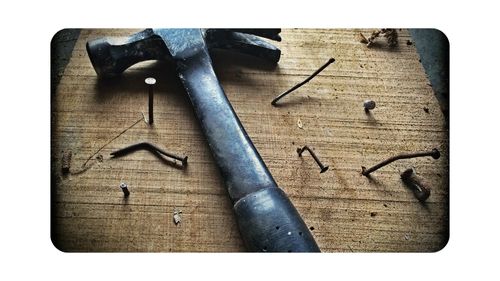There’s a wide world of wood fasteners you can use to build a bookcase.
Wood glues and screws are two particular favorites. They fasten securely, and are easy enough to use. However, it can be time consuming, turning every screw…or waiting around for glue to dry.
Sometimes you can even skip over fasteners altogether, and opt for a well-made dowel wood joint instead.
But what about nails?
Brad nails and finishing nails don’t have the same holding power as screws or a strong wood glue. Nevertheless, a power nailer can be a time saver when it comes to setting up large shelves.
But, between Brad nails and Finish nails, which one gives the best holding power for a book shelf?
Well, in this post you’ll learn the difference between Brad nails and Finish nails — and what this means for your bookcase. You will also find out whether those small Brad nails can hold up plywood shelves.
And keep reading to discover which tiny hand tool can help you hammer in finishing nails…without bending them.

This post may contain affiliate links to products that we receive a commission for (at no additional cost to you). Learn more here.
Are Brad Nails All That Different From A Finishing Nail?
The nails are pretty similar except for the fact that brad nails are much shorter than finishing nails.
Brad nails (18 gauge) don’t have great holding power either (due to being short). While finishing nails (15 gauge or 16 gauge nails) can keep thicker pieces of wood in place.
Related Post: Best Cordless Brad Nailers [Reviewed]
And Can You Use Brad Nails For Shelving?
Generally, Brad nails do not have the fastening power to keep something larger, like say a bookshelf, in place.
Brad nails are typically used on small lightweight wood crafts. And they’re sometimes used as temporary fasteners, holding two boards in place while wood glue joints dry.
Nonetheless, because of their smaller nail heads, Brad nails don’t create large puncture holes in wood (unlike Finishing nails).
But large bookcases need more robust fastening than a Brad nail can offer.
Will A Brad Nailer Be Enough To Put Up Through A Plywood Shelf?
If that plywood shelve is very thinly cut, (around 1/4 to 1/2 inch thick), then yes it can.
But, if you’re going to use plywood to make a shelf, it needs to be at least 3/4 inch thick. Any thinner, and that plywood shelf is probably going to sag.
So, Brad Nails can be used on very thin Plywood. However, you likely won’t be using very thin plywood to make a shelf in the first place.
You can learn more about using Plywood for shelving by checking out our post here: A Quick Guide To Choosing Between Plywood Or MDF For Shelves
Okay, But What About Finishing Nails? Are They Good For Shelving?
Compared to Brad nails, Finish nails are the best choice for thicker wood shelving. What’s more, these longer thicker nails can easily handle 3/4 inch thick plywood.
That’s why finishing nails are the go-to nail fastener for cabinets, molding, and shelves.
Still, while a finish nail can have great holding power, they come with one key disadvantage; puncture holes.
Finish nails can leave behind a very visible nail hole on the surface of wood. And the only way to disguise them is to use wood putty to fill in those holes.
Got It. One More Thing…Should You Use a Nailer Or A Hammer When Using Finishing Nails?
A power tool such as a nailer will save you a lot of time. But, you can hammer them into place too provided you use a ‘nail punch’.
A nail punch is a manual hand tool that makes it easy for you to hammer a nail head dead-center.
And, without a nail punch, you’ll probably end up bending those finishing nails more often than not.

So, if you want to prevent that from happening, check out our post right here: Why Finishing Nails Keep Bending (And What You Can Do To Fix It)
In that post we cover all you need to know to safely and consistently drive those finishing nails into place.
To Wrap Up, Here Are The 3 Key Takeaways From This Post…
- 1). Brad nails are shorter than finishing nails. They are ideally used to fasten thin wood and lightweight crafts.
- 2). Finishing nails are longer than brad nails, and have better holding power. These nails are used to fasten shelving, cabinets, and even molding into place.
- 3). Using a power nailer will save time. However, you can also manually hammer in finishing nails (without bending them) using a nail punch.


